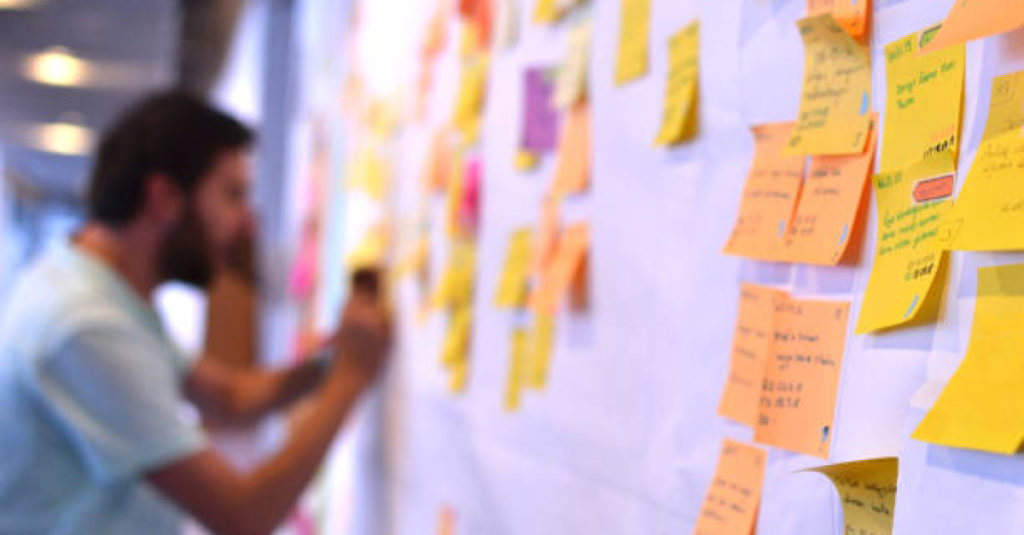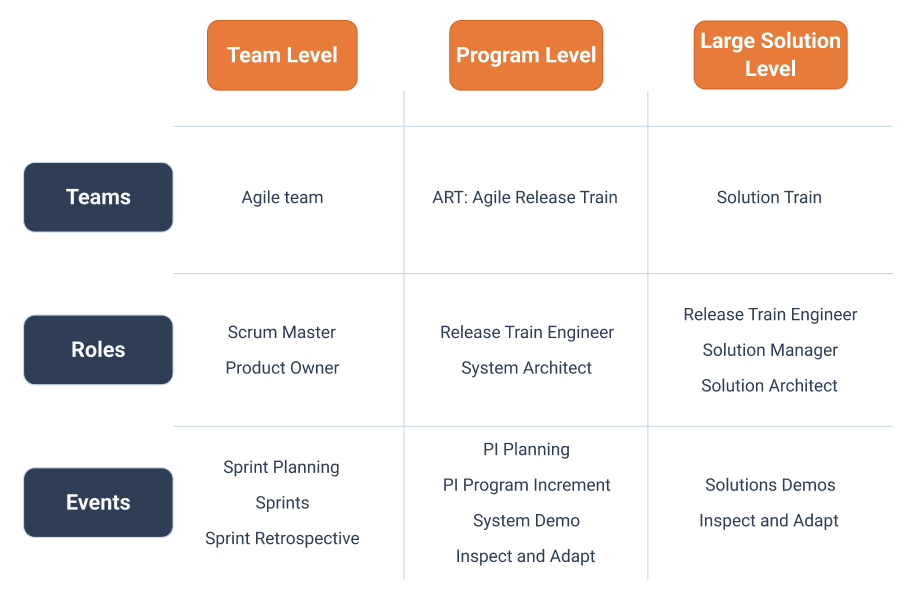
ESG principles, frameworks and best practices for Project Management
Align projects with ESG principles. Learn how companies use frameworks like GRI & SASB to meet sustainability goals and improve compliance.

What is SAFe? Is it the best approach to scale Agile at the enterprise level? Many project managers, PMO managers, IT managers and digital transformation leaders of organizations, who have been working for years with different Agile methodologies (Kanban, Scrum, etc), have asked themselves this question as a result of the barriers they have encountered in their day-to-day work when they realize that not all departments and teams in their organization have the same vision when it comes to delivering value for the business.
In recent years, several frameworks have been developed to scale the Agile approach at the organizational level. You’ve probably heard of acronyms like Less, DAD, DSDM or Spotify. All of them are frameworks for scaling Agile methodologies to larger teams or organizations.
But, why SAFe? Why is everyone talking about SAFe? In this article, we are going to describe what SAFe is, and why it can be the methodology your company needs to deliver value at the organizational level in an Agile way.
Surely you, as a Project Manager or digital transformation leader of your organization, have asked yourself some of these questions:
Not all organizations and teams have adapted in the same way to the digital transformation that all companies have had to face in recent years. Even within the same company, there are cases of departments that have been implementing Agile methodologies for years, coexisting with others that continue to resist change.

AGILE PORTFOLIO MANAGEMENT
Simplify SAFe Portfolio Management and achieve Enterprise Agility
Explore Triskell’s Agile Portfolio Management solution.
This will surely have caused delays, bottlenecks and lack of coordination between teams which, as a consequence, will have meant delays in product delivery dates or, in the worst-case scenario, seeing how the competitors get ahead of you by launching the same solution as you on the market.
Agile methodologies aim to deliver value to the user in the shortest possible time. And in the era of digital transformation, companies that struggle to adopt this approach will be at a disadvantage compared to those that do follow an Agile approach. SAFe is the framework that facilitates Agile scaling across the enterprise to help them create value more efficiently with a regular and predictable schedule.
Created by Dean Leffingwell in 2011, SAFe is a framework that designs scaled Agile in the enterprise along 4 levels:
Each level has its own roles, events and deliverables, but all of them are connected to each other to ensure that all stakeholders involved in generating value for the company (business and IT managers, development teams, finance, marketing, legal, etc.) use Agile and Lean practices to ensure they all consistently deliver value faster than the competitors.
SAFe’s roots are in the Agile teams already implemented within the organization. SAFe recommends that these teams adhere to the Scrum and Kanban methodology. In each iteration or sprint, teams should plan the next deliverables and an interaction planning event.
At the end of each sprint, the team must reflect and show the work they have been able to complete. Before the start of the next sprint, the team must look back and reflect on what can be improved for future iterations.
The Scrum Master plays a fundamental role at this level. In addition to being the coach, helping to improve and remove barriers and bottlenecks when they arise, either within the team or outside it, this person must communicate and coordinate with the Scrum Masters of other teams and participate in the Agile Release Train (ART), one of the most important events within the SAFe methodology, and which takes place at the next level: the Program Level.
WHITE PAPER
Combining Waterfall and Agile in SAFe
It is at this level that the ART (Agile Released Train) appears. An ART can be defined as an Agile team but at the program level. It is integrated by the Scrum Masters of the different Agile teams of the organization plus the relevant stakeholders for each case.
Based on the practice of delivering the right value at the right time, ARTs are made up of all the people necessary to be able to explore customer needs and deliver solutions. Like any team based on Agile practices, ARTs also work with iterations, which at this level are known as Program Increment (PI). PIs are the basis of the SAFe methodology, and their structure is similar to iterations at the team level:
At the Program Level, the equivalent of the Scrum Master is the Release Train Engineer (RTE), who acts as a coach and facilitator in the ARTs. They must also ensure that management at the highest levels of the company are continually committed to the value that ART produces in delivering tangible value to the company.
Sometimes, a single Agile Release Train is not enough to deliver a solution, and this is where the next level of the SAFe framework comes in: the Value Stream level. When one ART is not sufficient to provide a solution that delivers business value, then a Solution Train is needed. The Solution Train is used to coordinate several ARTs (between 3 and 10 ARTs) and vendors to deliver complex and far-reaching solutions.
This level within the SAFe framework is optional since this level is designed for large companies, which due to the type of products and services they focus on in their market (e.g. software, hardware, electronics, mechanics, optics, etc.) have to work with complex solutions that require several ARTs.
Solution Train follows the same work cadence as the PIs at the Program level, and there are three roles to highlight here:

And now, as the last level within this framework, SAFe proposes a final level that provides a strategic vision and serves as a guide to align the different departments of the Team and Program Levels in the achievement of common objectives and results.
At this level, it is broadly defined what brings the most value to the organization, and here Lean principles come into play to help organizations focus on those sprints and deliverables that really provide value, and avoid those that are too costly to the organization.
The SAFe framework, which is fully detailed on its website, scaledagileframework.com, requires a major transformation at the enterprise level in order to be implemented. This not only includes the creation of specific roles or events for its correct operation but also providing all the people directly involved with basic competencies for SAFe to be successful at all levels.
These are the core competencies that SAFe considers necessary for its correct implementation:
Leaders and managers of the organization must act as references, inspiring others so that the Lean and Agile practices proposed by SAFe are implemented at all levels in the organization, breaking down any resistance to change that may be encountered and guiding all teams and departments towards the new way of working.
All Agile teams should focus on creating solutions that add value for the company itself as well as for customers and users, always following Lean and Agile principles.
WEBINAR
Strategy Execution and Portfolio Management in a SAFe Agile World
In SAFe, organizations must focus on defining, building and having a continuous flow of products and services that deliver value to customers, while in parallel analyzing and exploring new solutions.
Lean and Agile principles must be applied throughout the entire supply chain, from the design and development phase to the release of new versions, whether they are software applications, network or security systems, hardware, etc.
Aligning strategy and execution following Lean principles will optimize operations across the entire project portfolio, and will also promote decentralized decision making.
It consists of promoting organizational agility through the creation of a management system for the company, reducing its operations and adapting in an Agile manner to market opportunities and threats.
SAFe urges all the people in the organization to learn and grow together, with exploration, creativity and continuous improvement being the fundamental axes of this continuous learning.
Learn how to boost Enterprise Agility with Triskell
Request a demo and see how Triskell can take your SAFe implementation to the next level.
Implementing these core competencies at all levels of the organization (teams, departments, management) plus scaling Lean and Agile practices to all these levels and the entire value chain of the company are only the first steps for the full potential of SAFe to be leveraged by the business. It is also necessary to carry out a series of implementations, both in terms of roles, deliverables and methodologies, to make SAFe a reality in your company.
SAFe lists in 10 the implementations that must be carried out for the SAFe methodology to be fully applied in your organization. For the successful implementation of Essential SAFe in your organization, these are the main changes that must be made at the organizational level in the business.
SAFe is based on a series of concepts that have evolved from Agile principles and methods, Lean product development and system thinking. These concepts are what shape the mindset and decision-making throughout the organization.
Agile and ART teams must be multifunctional and have all the necessary elements to produce, in an iterative way, solutions that suppose a value for customers and enterprise that works and are tested. If Agile teams cannot work iteratively along the value chain and ARTs cannot deliver solutions, they would not be working according to the SAFe methodology.
Cadence provides a rhythmic pattern, which offers a steady beat to the development process. It makes routine the things that can be routine.
Synchronization allows multiple perspectives to be understood and resolved at the same time. For example, synchronization is used to bring together the various assets of a system to assess the feasibility of the solution. Teams work in iterations on a schedule, with iteration planning and review, and ARTs are scheduled by Program Increments (PIs).
The most important event in SAFe is, without a doubt, PI Planning, which serves to set the basis for the pace of work in the ART and connect strategy with execution, ensuring that Business and IT are aligned. In other words, PI Planning aligns the entire ART on a common vision and objective for the entire organization.
SUBSCRIBE TO OUR NEWSLETTER
Get stories like this in your inbox
The main purpose of companies working with SAFe is to create a positive customer experience across the entire suite of products and services. SAFe also adopts the DevOps mindset and practices to enable more frequent and higher quality releases based on market demand. These practices ensure higher profits, greater employee engagement and higher customers satisfaction.
The value of the solutions provided in the ARTs has to be proven with evidence. And that evidence comes in the form of tests and trials in the System Demo, so all stakeholders can check the solution provided in the ARTs and provide the appropriate feedback to make the necessary changes or continue with the established line of work.
At the end of each PI, the event Inspect and Adapt is held, which is used for teams and stakeholders to reflect, collect data and define the actions and improvements needed to increase the quality and reliability of the next PI.
PI iteration occurs at each PI and serves multiple purposes. It serves to define the objectives of the PI, being an event in which innovation, continuous training, IP planning, and inspection and adaptation workshop take place. Many of the activities in these iterations are performed following Lean-Agile principles in order to provide solutions and value to customers and organizations in an agile manner.
The architectural runway consists of the code, components, and technical infrastructure needed to support the implementation of high-priority features in the near term, without excessive delays or redesigns. Underinvestment in the architectural runway slows the train and makes ART delivery less predictable.
For SAFe to be effective, company leaders and managers must take responsibility for the adoption and success of Lean-Agile. Executives and managers must become Lean-Agile leaders who are trained (and then become trainers) in these more agile ways of thinking and operating. If leaders do not take responsibility for implementation, the transformation to SAFe will fail.
Request a demo of Triskell Software
Are you interested? Would you like to have more information? These are just some of the features that Triskell has to offer. Request a demo of Triskell.

SAFe offers several benefits for enterprises adopting Agile methodologies, including:
No, SAFe is just one of the popular frameworks for scaled Agile. Other frameworks include Large Scale Scrum (LeSS), DAD (Disciplined Agile Delivery), and Scaled Kanban. The best framework for an organization will depend on its specific needs and size.
While SAFe offers many benefits, there are also some challenges to consider when implementing it:
There are several resources available to help organizations get started with SAFe, including training courses, certifications, and consulting services offered by Scaled Agile Inc., the creators of SAFe. Additionally, many online resources and communities can provide guidance and support.
Related Content

ESG principles, frameworks and best practices for Project Management
Align projects with ESG principles. Learn how companies use frameworks like GRI & SASB to meet sustainability goals and improve compliance.

10 types of Project Management Offices (PMO): structure, purpose and how to choose the right one
Learn about different PMO types, their governance levels, and which one is the best fit for your company’s project management needs.

How to create a project budget: methods and techniques for effective project budgeting
Learn how to create a project budget with this detailed guide. Discover essential methods and techniques for effective project budgeting in PPM.
Solutions
Platform
Company
Compare Triskell
© 2025 Triskell Software. All Rights Reserved.
Legal Notice
Privacy Policy
Cookies policy
Quality Management and Information Security System Policy

We use technologies such as cookies to store and/or access device information. We do this to improve the browsing experience and to display (non-) personalized advertisements. Consenting to these technologies will allow us to process data such as browsing behavior or unique ID's on this site. Not consenting, or withdrawing consent, may adversely affect certain features and functions.

Embrace Adaptive IT Governance to Accelerate Decision Making
Traditional IT governance is holding businesses back. This Gartner report introduces a flexible, outcome-driven governance model designed for speed, agility, and enterprise-wide impact.
Download now and learn how to modernize decision making across your organization.